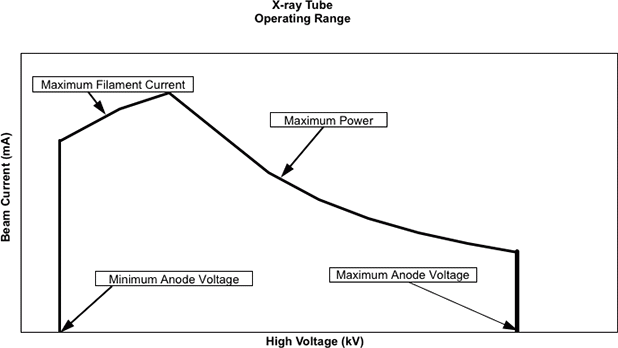应用
An X-ray tube is constrained in its operating range by four factors – maximum filament current, maximum power delivered to the anode, and maximum and minimum anode voltage. By operating your X-ray tube within these parameters, you may be able to achieve better results for your specific application while ensuring maximum longevity of your X-ray tube. This application note clarifies the constraints above and shows how an operating range is constructed. You can find all the particular values for your X-ray tube described in this application note on the datasheet.
The maximum filament current is a very strict constraint that prevents the filament from burning out, just like the filament in an incandescent light bulb. Like any other wire, a filament will melt because it cannot dissipate the heat generated from excessive current. Oxford Instruments X-Ray Technology has conducted extensive testing to determine the maximum current the filament in your X-ray tube can withstand. A typical value is 1.7A, but this value varies by filament type and is given on the datasheet that comes with your X-ray tube. It constrains the first part of the operating range before the maximum power requirement takes over.
Like the filament current limit, the power limit is a strict constraint that prevents the target from sublimating. An X-ray tube accelerates a very narrow beam of electrons to the target with a total power P = IV, where I is the beam current (not to be confused with the filament current – the current delivered to the filament itself) and V is the anode voltage. As you can see, this total power limit does not necessarily prevent using a higher beam current or voltage at a given power. Because beam current and voltage are inversely proportional in this relationship, raising one and lowering the other may still allow you to operate the X-ray tube within the maximum power constraint. Keep in mind that the anode voltage is limited as well, as detailed below. The maximum power constraint takes over after the filament limit is no longer a factor in the operating range.
An X-ray tube requires a minimum high voltage applied to the anode in order to draw off electrons from the filament. When this condition is satisfied, the beam of electrons will form and accelerate towards the target. Below the minimum anode voltage, electrons will not be drawn off the filament, and thus the tube will produce no X-rays. At voltages lower than the minimum, some power supplies will overdrive (and potentially melt) the filament in an attempt to produce beam current when there are no electrons available. It is extremely important that you do not attempt to obtain beam current below this minimum anode voltage to avoid damaging the filament. On the other hand, the X-ray tube can only stand off a maximum high voltage applied to the anode. Beyond this voltage, arcing will occur and this can severely damage your X-ray tube. Both the minimum and maximum high voltages are sharp cut-offs that form the left and right edges of the operating range.

Some applications may require different settings than the typical “full power” at which most customers operate their X-ray tubes. By following the guidelines in this application note, you may be able to achieve more desirable conditions for your application that still fall within the operating range constraints. In summary, to achieve the best possible conditions for your application, operate your X-ray tube within the constraints of maximum filament current, maximum power, and minimum and maximum anode voltage as described above.
 公安机关备案号31010402003473
公安机关备案号31010402003473